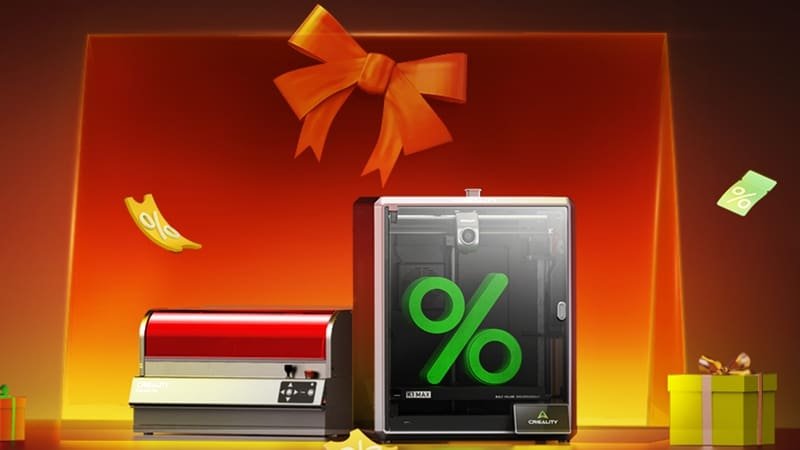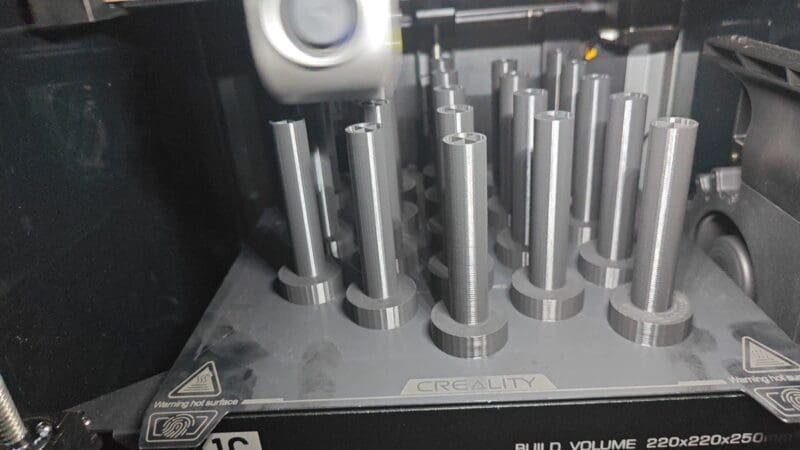PLA vs PLA+: What are The Differences and Which Filament Should You Buy?
1. Introduction to PLA and PLA+
PLA is a bioplastic and one of the most popular 3D printing materials. It’s easy to print, budget-friendly, and compatible even with basic 3D printers, making it ideal for beginner users. Although PLA filament has advantages, some drawbacks have led manufacturers to create enhanced versions of this material.
2. What is PLA+?
PLA+ (also known as Pro PLA or Tough PLA) is a modified version of standard PLA that has been formulated with additional materials to improve the performance of PLA 3D printing. Different filament manufacturers may use different additives, but all have similar properties. These “plus” elements can be fillers, pigments, nucleating agents, small quantities of other thermoplastics, or modifiers.

3. PLA vs PLA+: What are the Differences?
PLA (Polylactic Acid) is a thermoplastic commonly used in FDM 3D printing. It’s made from lactic monomers extracted from natural crops such as corn or sugarcane.
Printed parts made of polylactic acid (PLA) are not suitable for load-bearing applications that require high mechanical strength due to their low impact strength, even though it shares similar characteristics with polypropylene (PP) or polyethylene (PE).
Despite its shortcomings, PLA is inexpensive and readily available today. PLA+ is derived from standard PLA by adding modifiers during the synthesis process, improving it. To understand better the difference between PLA vs. PLA+, Let’s take a look at some of the comparison factors below :
PLA vs PLA+: Flexibility Comparison
PLA+ is a more flexible and less brittle material than standard PLA, with users of PLA+ filament reporting good ductility when printed parts are compared to those made from regular PLA. This makes it occupy a middle ground between the rigidity offered by ABS and the flexibility you would normally find in plain old PLA.
For instance, Sunlu’s brand of affordable and widely available PLA+ has an elongation at a broken rating of 45%. In comparison, ordinary PLA typically ranges only between 5–7% and ABS 10–50%.
Its enhanced elasticity over traditional 3D printing materials like ABS or standard PLA can deform parts instead of easily snapping under pressure due to its superior impact resistance. Thus, making them ideal for high-stress applications such as automotive components where conventional plastics may not be suitable for use.
PLA vs PLA+: Strength and Toughness Comparison
PLA is a strong 3D printer filament compared to ABS, but its stiffness and brittleness give it poor impact resistance. When broken, PLA often shatters into pieces which can be hazardous.
To address this issue, PLA+ was developed as an alternative material for printing functional parts that are more durable than normal PLA. While the strength of modified PLAs varies due to the lack of standard formula, overall, they offer greater durability than regular PLA, albeit with potential brittleness under certain conditions.
PLA vs PLA+: Temperature Resistance Comparison
PLA is a popular 3D printing filament due to its low printing temperature and relative ease of use. However, it has an inherent drawback when it comes to heat resistance. Warping or deformation can occur at higher temperatures. To combat this issue, developers have created PLA+ filaments more resistant to high temperatures than regular PLA.
These materials must be post-processed by being heated up (annealed) for their properties, such as thermal stability and ductility, to improve significantly. ProtoPasta’s HTPLA offers superior performance over traditional PLA with increased resistance against extremely hot environments after annealing.
PLA vs PLA+: Ease of Printing Comparison
When it comes to ease of printing, PLA is the clear winner. PLA is generally easier to print than PLA+ due to its lower extrusion temperature requirement. This makes it less likely for clogging and stringing issues, which are common with PLA+.
Additionally, the non-heated build plate users will face more adhesion issues while printing with PLA+ than with normal PLA. Standard PLA offers better resistance at slightly low temperatures when used on a beginner-level FDM printer, making it an ideal choice for PLA 3D printing applications.
PLA vs PLA+: Surface Quality Comparison
PLA+ is a high-quality version of PLA, promising a good surface finish on printed parts. The added materials in PLA+ help to improve the surface finish of printed parts, making them look more polished and professional. This makes PLA+ a popular choice for printing parts that will be visible to the public or used in functional applications.
PLA vs PLA+: Color Comparison
When it comes to color options, PLA always has a wide selection. PLA+ is more specialized and has a different level of demand than PLA, so you don’t get as many color options. However, go to other individual companies other than Amazon.
You can find some luck with certain colors, but it will be more time-consuming.
PLA vs PLA+: Storage Comparison
PLA filament can wear quickly due to moisture absorption, so storing it in an airtight container with desiccant packs is important to prolong its shelf life. PLA+ is also susceptible to moisture, but the filament’s added materials can help improve its resistance to moisture. It is still important to store PLA+ in an airtight container with desiccant packs, but it may have a longer shelf life than regular PLA.
PLA vs PLA+: Price Comparison
Material manufacturers typically charge higher prices for PLA+ filament than standard PLA, as it is designed to provide improved performance and print quality. Generally speaking, a kilogram of regular PLA costs between $15-$20, while the same amount of PLA+ can range anywhere from $25-$35.
4. Buyer’s Guide between PLA vs PLA+
Is PLA+ Better than PLA?
Even though PLA+ always offers some improvements over PLA in specific properties, PLA will still be a better choice in some situations.
Is PLA+ the Same as Tough PLA?
There is no standard formula for modified PLA, so it is difficult to say which material is stronger overall. Tough PLA filaments usually put greater emphasis on strength than other PLA+ formulas.
What is PLA+ Used For?
- While Standard PLA filament is great for rapid prototyping projects, PLA Plus is a good option for 3D printing projects that need better impact resistance.
- Heat-resistant PLA plus filaments are a better choice than PLA for projects with a lot of sun exposure.
- Water-resistant pro-PLA filaments would be ideal for prints left outside in the elements.
Is PLA Plus Worth It?
When choosing the best filament for a PLA 3D printing project, it is important to consider the cost of PLA+ compared to standard PLA. If you want to create functional parts that need strength and durability, then PLA+ provides improved features worth its extra expense.
However, if your goal is just visual models or prototypes, regular PLA may be more suitable due to its affordability. To ensure success with any brand of PLA+, testing out different extrusion temperatures depending on the printer model could save time in future projects.
In conclusion, investing in PLA+ depends mostly on what results you want from your prints and how much money and effort you invested into them; thus, weighing both pros & cons will help make an informed decision!
Does PLA Plus Need a Heated Bed?
PLA plus can be printed on various build platforms, with or without a heated bed. Though it is unnecessary for successful printing, using one may improve adhesion and reduce warping in the final product.
If you are having trouble achieving good results when printing PLA Plus, experimenting with different bed temperatures (around 60-70°C) and materials may help you find the optimal settings for your printer and filament.
Does PLA Plus Print Better?
The quality of prints made with PLA+ compared to standard PLA varies depending on the application and printing conditions. Some users report that using PLA+ yields better results, while others find similar success when using regular PLA.
Can You Use PLA+ in a 3D Pen?
Yes, it is possible; however, you should check the specifications of both your 3D pen and filament to ensure compatibility. This is because PLA+ typically has a higher printing temperature than standard PLA and may require a different type of 3D pen that can handle these higher temperatures. Additionally, due to its increased viscosity when heated, working with this material might prove more difficult compared to other filaments for 3D pens.
What Temperature Should PLA+ be?
Some PLA+ filaments have higher printing temperatures than traditional PLA ranges (around 220C instead of 200C). However, a standard PLA printer can accommodate these higher temperatures. If your printer does have issues hitting those higher temps, try switching to a different PLA+ brand.
5. Conclusion: Which FDM Filament Should You Buy?
The decision as to whether or not you should use PLA Plus filament depends on your individual needs. Enhanced PLA Plus filaments are designed with the desirable qualities of regular PLA in mind, such as its brittleness and low heat tolerance while attempting to reduce moisture absorbency.
Although some companies have successfully produced superior versions of PLA+, it is important to remember that its presence only sometimes guarantees satisfactory results from any given brand or seller.
In addition, neither standard nor enhanced PLAs tends to be high-performing thermoplastics compared to other materials available for 3D printing. Ultimately, the best approach would be to research different brands and sellers to determine which will provide optimal performance according to your specific needs.
DISCLOSURE: THIS POST MAY CONTAIN AFFILIATE LINKS, MEANING I GET A COMMISSION IF you DECIDE TO MAKE A PURCHASE THROUGH MY LINKS, AT NO COST TO YOU. PLEASE READ MY DISCLOSURE FOR MORE INFO.



